LA Phil at 100: How the orchestra rose from humble roots to become one of the world’s best
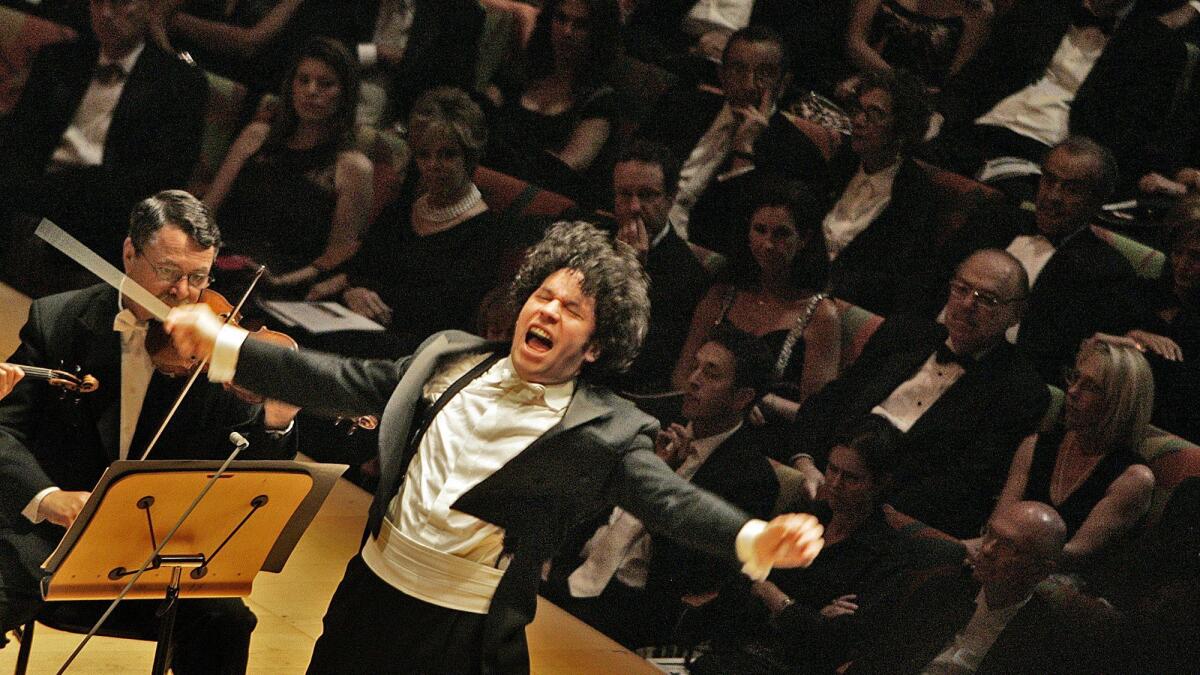
- Share via
How did it happen?
An outlier orchestra far from the center of Old Europe and never admitted to the so-called Big Five — the lofty philharmonics and symphony orchestras of New York, Boston, Philadelphia, Cleveland and Chicago — that once dominated America, the Los Angeles Philharmonic has become the most significant and successful major orchestra anywhere. Astonishingly, this insurgency involves a supposedly traditional symbol of cultural elitism in La La Land, Tinseltown, the Land of the Plastic Lotus, a place, as Woody Allen’s tired slam goes, “where the only cultural advantage is that you can turn right on a red light.”
Well, one corner where you can’t turn right on a red light is on your way out of the Hollywood Bowl after an LA Phil concert. And though a right on a red may be permissible downtown, who wouldn’t rather pause at an intersection and ogle the visually sexy Walt Disney Concert Hall? Once multimedia artist Refik Anadol’s video projections illuminate the nighttime steel exterior of Frank Gehry’s architectural masterpiece — Sept. 27 through Oct. 6 — as part of the opening celebrations that begin the LA Phil’s centennial season, you will be able to thank (or curse) the orchestra for outright gridlock from rubberneckers.
The LA Phil’s upcoming season will lead to the 100th anniversary of the announcement in the Los Angeles Times on June 11, 1919, of a new orchestra for a booming town. This season of its centennial, the institution will surely break every orchestra record in the book with more than 50 commissions of new work. There will be a multitude of dance, theater and opera projects. There will be symphonic cycles; crossovers into pop and jazz, world music and film scores; a spotlight on Los Angeles’ African American symphonic music and the avant garde. Then there are the numerous community events including a massive eight-mile street party and a free Hollywood Bowl concert; and projects for its youth orchestra YOLA. Oh, yes, there’s also that $500-million fundraiser close to its goal. A big gift from John Williams. I’m surely leaving something out.
How the LA Phil became the envy of classical music may be what everyone wants to know. It’s maybe even more useful, though, to ask why as well. The story of the LA Phil feat is ultimately about a reason for being. Every great orchestra has had its heydays when it has been uniquely true to its place and population and purpose and art and era.
A symphony for an incipient city
TIMELINE: The Los Angeles Philharmonic through the years »
We don’t choose our parents, and the LA Phil was born to an eccentric father. In 1919, the urbane black-sheep son of a Montana mining and railroad magnate — and Gilded Age scoundrel who reputedly bribed his way into the Senate (and was called “the most disgusting creature that the republic has produced since Tweed’s time” by Mark Twain) — decided L.A. needed an orchestra superior to the then-struggling, 11-year-old Los Angeles Symphony. William Andrews Clark Jr., an amateur violinist and rare-book collector who built a mansion on West Adams Boulevard, founded the Los Angeles Philharmonic as an alternative to the floundering Los Angeles Symphony (which he finished off by stealing its best players) and underwrote some $3 million in losses until his sudden death in 1934.
The man and the moment were right. L.A. already had movies. The Hollywood Bowl was about to be built, and the LA Phil got involved almost from the beginning, uniquely bridging classical and popular culture. The KNX radio station helped usher in radio in 1920, and the LA Phil was the first orchestra anywhere to broadcast a full concert. Artists, inventors (like the father of John Cage, who was born downtown at Good Samaritan Hospital in 1913) and outsiders were attracted as if by a magnet to a city of possibilities. The Los Angeles Philharmonic grew up as a child of its time.
That meant Clark’s orchestra wouldn’t operate out of the hermetic classical music box, so to speak. Instead he redefined the box as modern, indoor-outdoor L.A. architecture. An aesthete, Clark clearly wanted something fancy-schmancy. But he was also an outdoorsman from Montana who sought an unstuffy, accessible ensemble, equally at home at schools, public parks and the Hollywood Bowl as in its then-lofty downtown hall.
An L.A. Times review from Oct. 25, 1919, of the premiere concert recounts the scene: “The audience was not especially notable as to size, the glamour of a premiere was not broadly apparent, but the people who were there represented musical taste.”
The first three music directors — Gustav Mahler’s assistant Henry Rothwell, Finn and Jean Sibelius’ friend Georg Schnéevoigt and the volatile, upcoming young Pole, Artur Rodziński – were not the ones to shake things up. But they had one pertinent thing in common: a connection to the living composers.
The teen years
LA Phil’s new CEO Simon Woods is helping to reframe what it means to be an American orchestra »
The connection between the LA Phil and the early sound pictures with their lavish orchestral scores is a little slippery. However weary the orchestra’s first big-name music director — the serious and imperious Otto Klemperer — was toward Hollywood during his tenure in the 1930s, the close proximity to the movie industry made it impossible to keep the worlds apart.
When he stepped off the train for the first time at Santa Fe Station in 1933, Klemperer may not have been able to answer waiting L.A. Times reporters’ questions about his favorite movies or stars. But the music world was clearly excited. The Times reported that Klemperer was “greeted with a fanfare from the brass section of the Los Angeles Philharmonic Orchestra.”
The German conductor knew next to nothing about L.A. He had simply been desperate to get out of Adolf Hitler’s Berlin, which was under Nazi control in 1933.
His first culture shock was, while staying with Clark, his host’s habit of breakfast in the nude. His second culture shock was being called “Klempie” by the players.
Yet, the LA Phil’s teenage years proved one of the most remarkable — and too little recognized — eras in orchestral history. Klemperer made his ensemble world class (if still dismissed by the Big Fivers). Furthermore, recognizing that L.A. was home to the two greatest composers of the first half of the 20th century, the competitive Igor Stravinsky and Arnold Schoenberg, Klemperer championed both.
Making its mark
By the end of the 1930s, the LA Phil had a recognizable personality. It was a well-grounded but highly flexible ensemble with an unmistakable vitality. It was a pioneer in inviting a woman to conduct (that didn’t go well at first) and hiring African American players. It took bold chances, presenting avant-garde music at, of all places, the Hollywood Bowl.
Edgard Varèse’s revolutionary all-percussion score, “Ionisation,” for instance, was played on a 1933 Hollywood Bowl program titled “Symphonies Under the Stars.” It was a revelation for a young John Cage that helped inspire his devotion to percussion, which has had a lasting effect on American music. English conductor Leopold Stokowski undertook wild experiments with electronic effects and the LA Phil, something he couldn’t so easily get away with with his own Philadelphia Orchestra.
The intermingling of traditional values and experimentation never comes easily . The orchestra still had a lot to figure out. In 1943, the LA Phil came up with another major U.S. orchestra first, this time hiring an American music director, Alfred Wallenstein. He was a tyrant. He lacked charisma on the podium. But he was a solid musician. He was not adventurous, but he did program living American composers.
An angel of Los Angeles
Management is another slightly odd area of LA Phil lore. It was run by non-professionals up to the hiring of Ernest Fleischmann in 1969. Clark left the orchestra nothing in his will, which meant years of trying to invent funding schemes. It did, though, have its angels, and most notably Dorothy Buffum Chandler, the strong-minded wife of L.A. Times publisher Norman Chandler, who left no checkbook unturned raising money to save the Hollywood Bowl when it was about to go bankrupt in the early 1950s and then to build the Music Center, anchored with the city’s first dedicated concert hall, the Dorothy Chandler Pavilion.
Her other great feat was to hire the dashing but as-yet-untried, 25-year-old Zubin Mehta as music director in 1961, who was then on hand to open the new hall three years later. None of this was by the book. Chandler operated by a combined sense of civic duty, instinct and personal profit (the Music Center having the advantage of being good for the Chandlers’ downtown property interests).
A controversial rising star, Mehta essentially created the modern LA Phil. He came onboard with the notion that it mattered more to play all the orchestral music of Schoenberg right away than work right away through another Beethoven symphony cycle. Fortunately, there was no one to stop him.
He was too flashy or superficial or “foreign” for some. He could also be too traditional for others in his attempts to create a Vienna Philharmonic sound. But that made Mehta perfect for L.A. All that was needed was a manager with a never-ending supply of chutzpah, a shameless promoter who was also a knowing musician and master professional.
Fleischmann and Mehta undertook a full-scale orchestral revolution. It was often messy. But there was a sense that an orchestra had to stand for something and it did, as when Mehta and the LA Phil daringly played at a UCLA anti-Vietnam War rally in the early 1970s or endeavored to collaborate with Frank Zappa and his Mothers of Invention.
Defying expectations
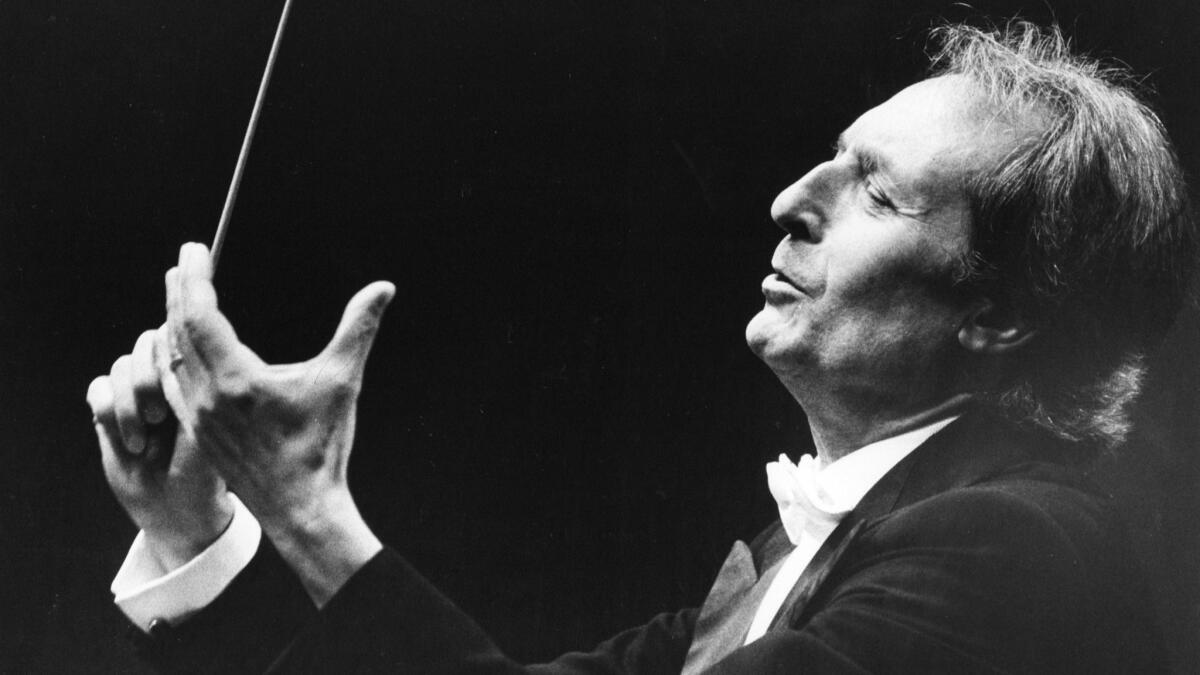
By the time Mehta decamped to the New York Philharmonic in 1978, the LA Phil had, thanks in part to Fleischmann’s promotional flamboyance, more of a reputation for flair than substance. Never easy to pin down artistically, Fleischmann broke that mold by appointing a beloved elder Italian orchestra statesman, Carlo Maria Giulini, as Mehta’s successor. He meant to break that mold next with André Previn, who, instead, came as a classicist wanting to put long behind him his early career as a film composer and jazz pianist.
Yet that only gave Fleischmann more leeway to mastermind the LA Phil’s moves in new directions. He formed a new music group within the orchestra, a first, which is now widely imitated. He went on the warpath for a modern concert hall, making sure that, by hook or by crook, it would be designed by his close friend Frank Gehry (there was a competition, but the winner was a forgone conclusion).
Finally, Fleischmann had long had his eye on Esa-Pekka Salonen as representing the future. He got him even if it meant underhandedly pushing Previn out.
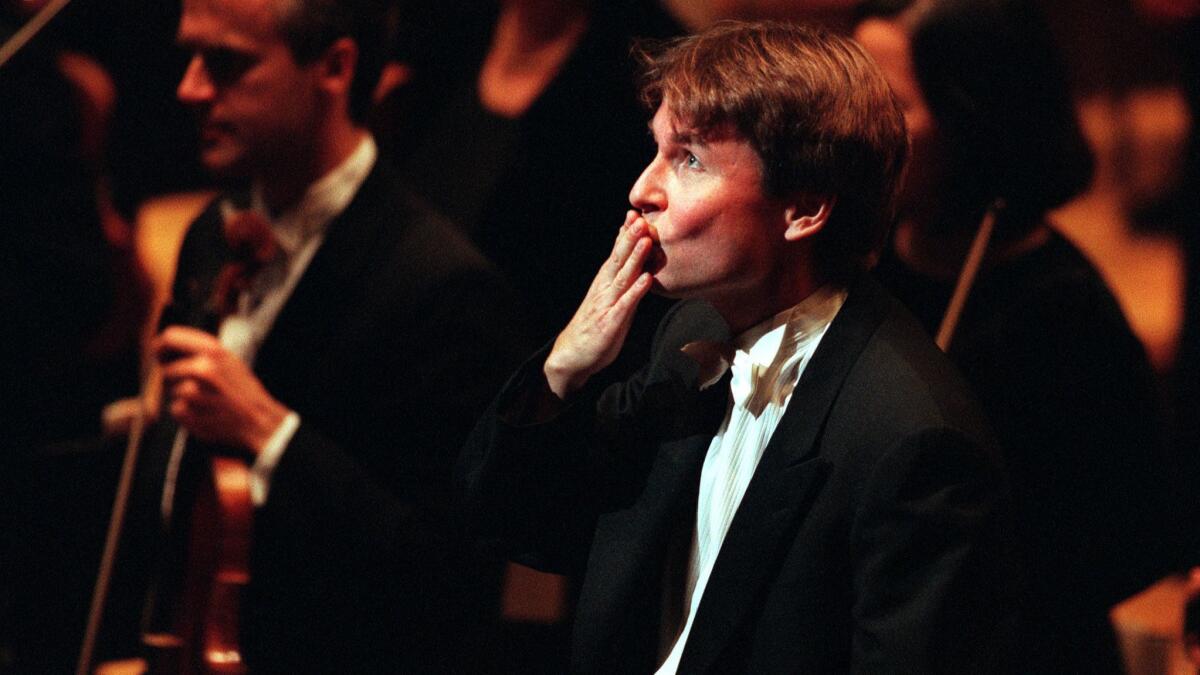
It is easy to forget, given the universal adulation Salonen now commands and his place in the hearts of the LA Phil and its public, just how radical a move this was on Fleischmann’s part. There was resistance from a number of players, the audience and The Times. Salonen arrived, moreover, in 1992, during L.A.’s bad few years of rioting and recession. After having been initiated six years earlier thanks to a $50-million gift from Lillian Disney, the new concert hall to be named after her late husband, Walt, had come to a fundraising standstill.
Fleischmann also let nothing deter him in his vision of a modern orchestra that played music of our time and a hall suited for it. Purists and many patrons were appalled by Gehry’s architecture. In the early 1990s, the project was generally considered hopeless. But Fleischmann insisted on looking ahead. He cared little about deficits. He knew it took time to build audiences as well as concert halls.
When the Green Umbrella — his whimsically named, groundbreaking new music concert series — was about to be killed by the board to help balance the budget, Fleischmann and Salonen underwrote it themselves.
You know the outcome. Disney got built and instantly became an L.A. landmark and model for the modern concert hall. In his 17 years leading the LA Phil, Salonen made it the new, relevant model of the modern orchestra.
Now Green Umbrella tickets sell like hotcakes.
Reimagining the orchestra
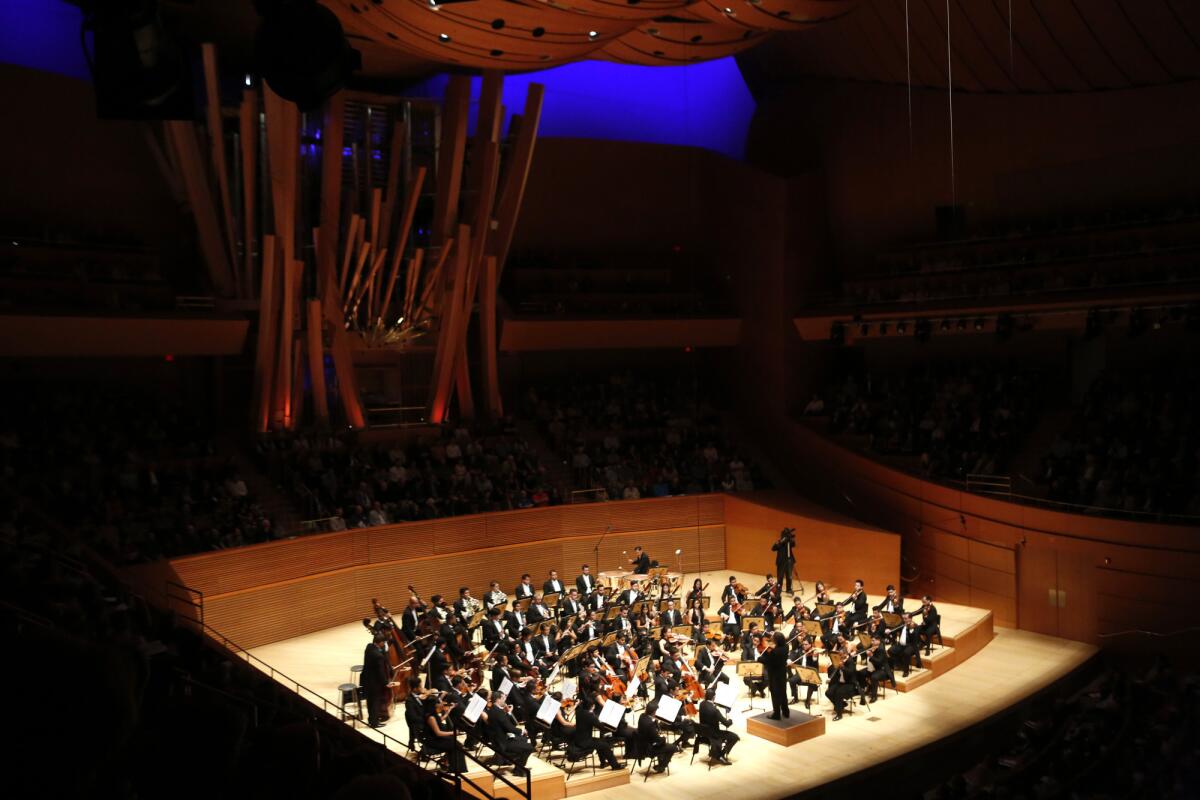
None of this is unrelated, and it took one final persistent manager to ultimately make Fleischmann’s vision a reality. When he stepped down in 1998, Disney was finally being built and would open in 2003, but the challenge was to proceed with all the artistic plans Fleischmann had in place as though the organization could pay for them. It hired the wrong man from the Royal Concertgebouw Orchestra in Amsterdam.
In a brief 18 months before he left amid controversy, Willem Wijnbergen seemingly angled to unseat Salonen, demonstrated a greater interest in the Hollywood Bowl than Disney Hall and created what could have become fatal palace intrigue inside the orchestra.
Deborah Borda, who was hired away from the New York Philharmonic, had the reputation for brilliantly strengthening structural and financial problems. She was strong and feared and not well liked in New York and probably wouldn’t have lasted much longer there.
But for L.A. when she arrived, but she had a key strength Fleischmann lacked. She didn’t think she had all the answers.
Instead of wanting to remake the institution in her own image, as Wijnbergen attempted, she valued Fleischmann’s and Salonen’s visions, and remade it as it had never been before. She balanced the budget without compromising artistic priorities, giving patrons the strongest reason for wanting to support the orchestra. She understood that Disney Hall, which she opened magnificently, was not just a symbol but a tool to be used to reimagine what an orchestra could be. She thought of the orchestra as a family, a place where soloists and composers would develop a regular relationship with the orchestra.
Salonen was allowed to experiment and think big. And when Fleischmann and Salonen discovered Gustavo Dudamel in a German conducting competition, she then managed two great coups. Not only did she sign one of the greatest natural conducting talents since Leonard Bernstein to be music director at age 27 but she also empowered him in his vast – and enormously expensive — musical ambitions as well as his social concerns, particularly music education for underserved youth.
Colliding past and future
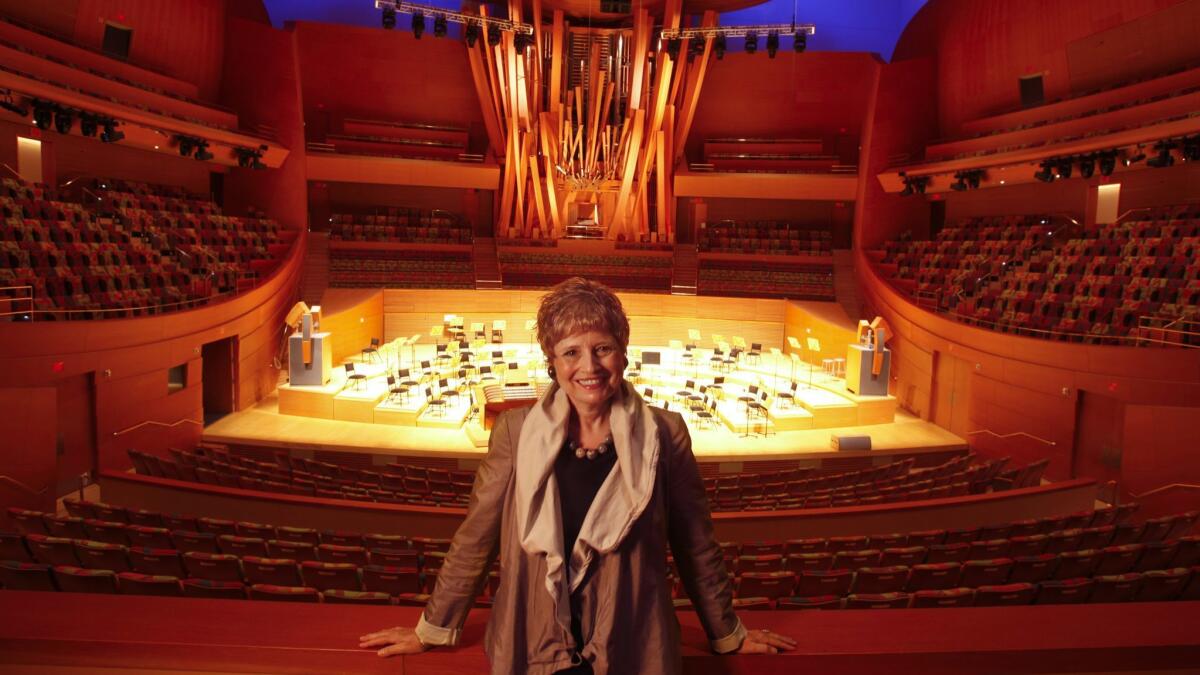
Now for the final LA Phil secret.
It is, of course, Disney Hall. The miracle of the hall is that it looks like the future. It feels like the future to be inside it. But it sounds like and it acts like the past. It is, under all its sheen, one of the best traditional halls in the world.
In the end, the hall is about one thing and one thing only. The orchestra. Its sound and everything it stands for is made to feel both physically present and of the moment and, with Gehry’s architecture, echt L.A., a lotus no longer plastic but coated in the most alluring and musical steel on the planet.

More to Read
The biggest entertainment stories
Get our big stories about Hollywood, film, television, music, arts, culture and more right in your inbox as soon as they publish.
You may occasionally receive promotional content from the Los Angeles Times.











